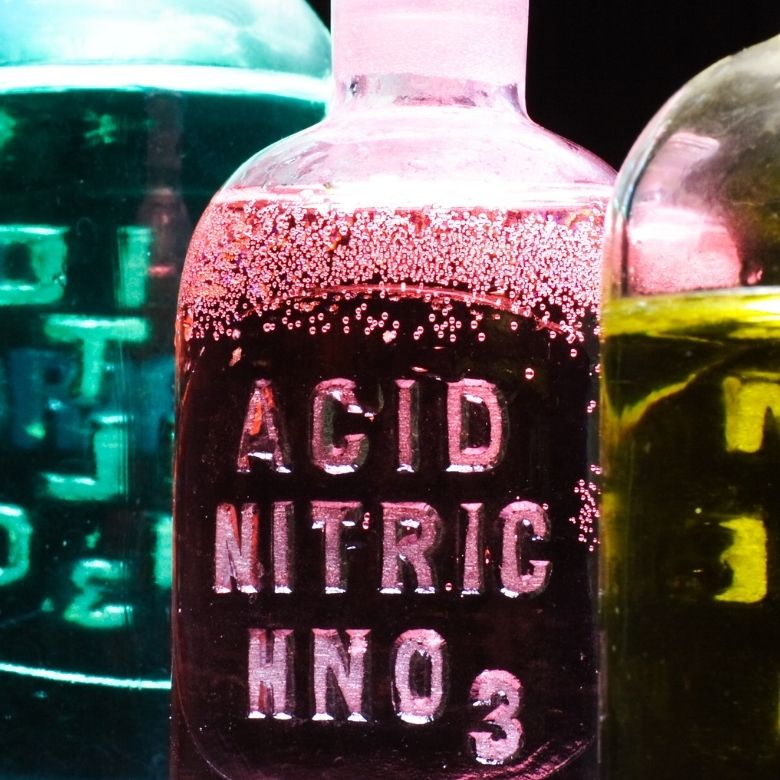Nitric acid HNO3 is one of the most important inorganic acids. As a key component of fertilisers, it is one of the most widely produced chemical raw materials in the world. According to Fortune Business Insights analysts, demand for it will continue to grow in the coming decades.

Nitric acid – properties
The earliest records of nitric acid date back to the 14th century and the first bold alchemical attempts. At that time, it was used to produce so-called royal water (aqua regia), a solution capable of dissolving gold and platinum. In fact, HNO3 is highly corrosive and very chemically active.
Nitric acid (V) is a colourless liquid with an extremely pungent odour and corrosive properties. When stored for a long time and exposed to temperature, it turns yellow due to spontaneous decomposition into nitrogen oxides and water. It reacts readily with numerous substances and produces heat when dissolved in water. A significant proportion of reactions involving it are even explosive.
Both nitric acid itself and its salts are strong oxidizers. This fact explains the violence of the reactions with metals, which result in the release of hydrogen. However, inactive metals and some non-metals, such as sulphur, phosphorus and carbon in the form of graphite, also react with HNO3. The latter oxidise to acids.
Concentrated nitric acid is highly hazardous to health. Upon contact with the skin, it causes severe burns and even necrosis. As vapour, it attacks the respiratory tract, leading to swelling and pneumonia. Accidental consumption of HNO3, on the other hand, can cause death due to perforation of the stomach or intestinal wall.

How is nitric acid (V) obtained?
Nitric acid can be obtained by reacting nitrogen dioxide with water. For commercial purposes, the basic production method is the so-called Ostwald process. This is the catalytic oxidation of ammonia to nitric oxide, which, using special absorption towers, yields concentrated HNO3 acid. For purchase, a concentration of 65–68% is most desirable.
Under laboratory conditions, an alternative production method is the reaction of potassium nitrate with sulphuric acid to produce pure nitric acid (V).
Nitric acid applications
Neutralization of nitric acid with ammonia results in ammonium nitrate – the most important component of mineral fertilisers used worldwide. It provides crops and ornamental plants with the nitrogen they need to grow, in high, easily digestible doses. In addition, HNO3 can be used for soil acidification in horticulture.
In the chemical industry, nitric acid (V) is primarily a precursor to organic nitrogen compounds, such as nitrobenzenes. When combined with aromatic compounds, it yields substances used to make explosives such as TNT and nitroglycerine.
Another important application is rocket fuel. For this purpose, a mixture of HNO3, dinitrogen tetroxide and hydrogen peroxide, also known as red fuming nitric acid, is prepared. Its use in the space industry depends on the ability to store the raw material efficiently.
Nitric acid’s potential for plastic production is also noteworthy. The oxidation initiated by it produces adipic acid which is further used to produce synthetic fibres such as nylon.
Other, less popular uses of nitric acid (V) include:
- production of organic dyes and lacquers;
- pharmaceutical industry;
- production of fungicides;
- cleaning and etching of metal surfaces;
- refining of precious metals for the jewellery industry;
- the artificial ageing of wood to obtain the desired shade;
- production of household cleaning products;
- detection of traces of metals in laboratory test substances.

Concentrated nitric acid and safety precautions
Because of the explosive nature of the reaction and the resulting mixtures, as well as serious health hazards, nitric acid (V) requires special care during its storage and handling. ADR regulations on the transport of dangerous goods state it should be transported in aluminium tanks or tankers with the appropriate labelling.
Special containers resistant to nitric acid are used for its storage. They must be properly sealed and stored out of direct sunlight at temperatures below 20°C. There should be no metals or flammable substances in the vicinity. The room itself must be well ventilated.
Concentrated nitric acid also requires the use of personal protective equipment when handling the raw material. Every person in contact with the acid must wear a respirator, protective goggles and acid-resistant clothing and gloves. After working with nitric acid, it is advisable to wash hands and face thoroughly and cover the skin with a barrier cream.
How does nitric acid (V) affect the environment?
Accidental release of HNO3 acid into the environment poses a risk to humans, animals and plants. The acid must, therefore, be prevented at all costs from leaking into surface water and groundwater. Any spills must be cleaned up immediately with absorbent materials or by pumping out.
Nitric acid is a widely used raw material and plays a key role in the fertiliser, explosives and synthetic plastics industries. However, the benefits associated with its use must not overshadow the potential risks. Responsible compliance with applicable regulations is the best way to prevent life-threatening accidents.
- https://pubchem.ncbi.nlm.nih.gov/compound/Nitric-Acid
- https://webbook.nist.gov/cgi/cbook.cgi?ID=7697-37-2
- https://encyklopedia.pwn.pl/haslo/azotowy-V-kwas;3872903.html
- Podręczny słownik chemiczny, Romuald Hassa (red.), Janusz Mrzigod (red.), Janusz Nowakowski (red.), Katowice: Videograf II, 2004, s. 208,